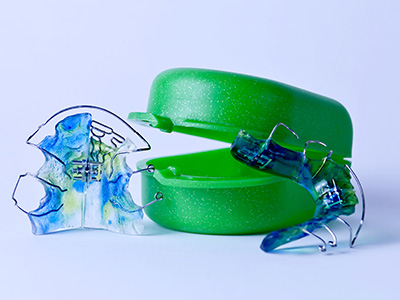South Forsyth County

Our Offices
574 Peachtree Parkway
Suite 110
Cumming, GA 30041
Existing Patients: (770) 886-8911
New Patients: (770) 406-0667
Downtown Cumming

Orthodontic appliances are more than accessories to braces — they are active tools that help preserve function, protect teeth, and guide growth. Depending on the clinical objective, an appliance can hold space after early tooth loss, apply targeted forces to shift teeth, or shield dental structures during contact sports. When chosen with a clear treatment plan in mind, these devices contribute directly to long-term oral health and predictable outcomes.
Patients often think of appliances only in terms of appearance, but their primary role is mechanical and biological: to influence tooth position, support jaw relationships, or protect tissues from injury. A well-designed appliance addresses the underlying problem — whether that’s a developing crossbite, a tendency to grind, or the need to maintain alignment after active movement. That focus on function is what makes appliances a cornerstone of contemporary orthodontic care.
Good communication between clinician and patient turns an appliance from a prescribed gadget into a manageable part of daily life. Clear expectations about how the device will feel, how long it will be worn, and what changes to anticipate help patients follow instructions and avoid unnecessary setbacks. In the hands of an experienced orthodontist, properly selected appliances make treatment smoother and more effective for children, teens, and adults alike.
Today’s orthodontic appliances cover a wide clinical spectrum. Removable devices such as clear aligners and retainers provide versatility: they can hold teeth in place, apply gentle directional forces, or be used as transitional wear after major treatment. Fixed appliances — including bands, brackets, and bonded splints — offer continuous control when precise tooth movement is required. Other specialty devices, like palatal expanders or space maintainers, intervene at key developmental stages to influence arch size and tooth position.
There are also appliances designed primarily for protection and comfort. Custom mouthguards protect teeth and orthodontic hardware during sports, while occlusal splints can reduce the impact of clenching and grinding. Functional appliances act on jaw growth by altering muscle and bite patterns, and temporary anchorage devices (TADs) provide stable points of resistance for complex tooth movements in selected cases. Each appliance has a specific clinical niche based on anatomy and treatment goals.
Understanding these distinctions helps patients recognize why one solution is chosen over another. For example, an expander may be recommended for a child whose upper arch is too narrow, whereas a retainer will be the mainstay for maintaining alignment once braces or clear aligners have completed their job. Matching the device to the intended biological response is what yields lasting, healthy results.
Fit and fabrication are central to how well an appliance functions. Custom-made devices are produced from digital scans or impressions of the mouth and are tailored to the patient’s exact anatomy — teeth, gums, and bite relationships. That precision improves comfort, retention, and the predictability of tooth movements, while reducing unwanted pressure or soft-tissue irritation. In clinical practice, a tailored approach is often the difference between efficient progress and avoidable delays.
Over-the-counter or boil-and-bite options can serve as stopgap measures when immediate protection is needed, but they are not substitutes for professionally designed appliances when therapeutic control is required. A custom mouthguard, for instance, distributes force more evenly and accommodates brackets and wires; a lab-fabricated retainer conforms to occlusion in ways a generic device cannot. For clinical applications that demand accuracy, laboratory or digital customization provides measurable benefits.
That said, practical decisions sometimes involve trade-offs. An orthodontist will recommend the safest and most effective option for a patient’s situation, and when a temporary or interim device is appropriate, they’ll provide guidance on transitioning to a long-term, custom solution. The goal is always to balance immediate needs with durable oral health protection.
Active orthodontic treatment creates special considerations for appliance selection and daily habits. Standard off-the-shelf devices may not fit comfortably over brackets and wires, so patients involved in sports or high-impact activities often receive guards specifically shaped to accommodate orthodontic hardware. These designs protect both the teeth and the appliances without interfering with treatment mechanics.
Some therapeutic appliances are intended to be worn alongside braces or aligners to influence jaw growth or tooth movement. Functional appliances and TADs, for example, are used selectively and require regular monitoring and occasional adjustments. Close collaboration between the patient and the orthodontic team ensures that these supplementary devices are applied safely and removed or modified as treatment progresses.
Patients with additional dental work, TMJ concerns, or special-needs considerations benefit from a coordinated plan that brings other dental specialists into the conversation. Whether it’s adjusting a restorative margin, protecting sensitive restorations, or adapting a device for comfort, a multidisciplinary approach makes appliance therapy more predictable and less disruptive to daily life.
Routine care preserves appliance function and prevents small issues from interrupting treatment. Removable devices should be cleaned gently each day with nonabrasive soap or a recommended cleaner and kept in a ventilated case when not worn. Fixed appliances demand diligent oral hygiene to prevent plaque buildup around brackets and bands; patients should use the brushing and interdental techniques demonstrated by their orthodontic team to protect both teeth and hardware.
Follow-up appointments are essential for monitoring progress, making adjustments, and performing repairs if an appliance loosens or breaks. If irritation, sharp edges, or persistent soreness occurs, prompt evaluation prevents minor problems from becoming treatment setbacks. Similarly, visible wear or loss of retention signals that a device may need to be remade or replaced to maintain effectiveness.
Appliances are durable when cared for properly, but they are not indestructible. Growth, changes in tooth position, or routine wear can necessitate updates over time. Regular communication with your orthodontist ensures the appliance continues to meet clinical goals and provides the protection or guidance intended for a healthy, lasting smile.
Orthodontic appliancess play many roles: protective, corrective, and preventive. When selected and maintained under professional supervision, they help people of all ages reach and preserve healthy, functional smiles. If you’d like to learn more about available appliances or how they might fit into a treatment plan in Cumming, GA, contact Inspirational Smiles Orthodontics for information tailored to your needs.
Orthodontic appliances are devices used to protect teeth, guide jaw and tooth growth, and support overall oral health. They do more than improve appearance — they help maintain function, prevent injury, and ensure predictable treatment outcomes.
Appliances include removable devices like clear aligners and retainers, fixed devices such as bands and brackets, and specialty tools like palatal expanders, space maintainers, functional appliances, temporary anchorage devices (TADs), occlusal splints, and custom mouthguards. Each is chosen based on clinical goals, age, and anatomy.
Appliances hold teeth in place, apply targeted forces for alignment, influence jaw growth, and shield dental structures from injury. Functional appliances correct bite patterns or encourage favorable jaw development, while protective devices like mouthguards safeguard teeth and orthodontic hardware during sports.
Custom-made appliances are crafted from digital scans or impressions for a precise fit, improving comfort, function, and treatment predictability. Generic or over-the-counter devices may provide temporary protection but cannot achieve the same level of therapeutic control as professionally designed appliances.
Appliances are incorporated with clear guidance from the orthodontist to ensure comfort, proper function, and safety. Patients with braces or high-impact activities may use specially designed guards or functional devices that work alongside their main orthodontic treatment, while multidisciplinary coordination helps accommodate TMJ concerns or restorative work.
Removable appliances should be cleaned daily with nonabrasive soap or a recommended cleaner and stored in a ventilated case. Fixed appliances require diligent oral hygiene to prevent plaque buildup. Regular follow-ups allow for adjustments, repairs, and monitoring of fit and effectiveness.
If your appliance feels uncomfortable, has sharp edges, shows signs of wear, loses retention, or breaks, contact your orthodontic team promptly. Early evaluation prevents minor issues from disrupting treatment and ensures the appliance continues to meet its protective or corrective goals.
Under professional guidance, appliances help protect, correct, and prevent problems effectively. Orthodontists ensure devices fit properly, function as intended, and integrate with your overall treatment plan, supporting a healthy, functional, and long-lasting smile.



No referral is needed; your first visit includes a complimentary consultation to see how orthodontic treatment may help you. We invite you to be our special guest.
